“Store Refresh on a Budget - Part 1” in the March/April issue of
Furniture World (https://www.furninfo.com/furniture-world-articles/4047) presented the first six of 15 effective ways to improve the look of
retail furniture stores without investing in a major renovation that will
cost a minimum of $30 per square foot. These included:
-
Maybe It’s Time to Rethink Your Barstool Displays.
Now is an excellent time to think about how you display bar stools.
Metal brackets inserted into wall standards can easily be adjusted to
display stools at different heights. Adding a shelf to create an
upper-level display provides high visibility. A duplicate lower row
allows customers to test drive the stools. Freestanding shelving units
can also work well for displaying barstools.
For stores that cannot make a two-level approach work, another option is
to source two large tables, one at counter stool height and another at
barstool height. Group stools around each table to allow customers to
determine the stool height that works best for them. Check with barstool
vendors to find out what might be available before building out your
display. Amisco, for example, has an attractive display that walks
customers through its customization options.
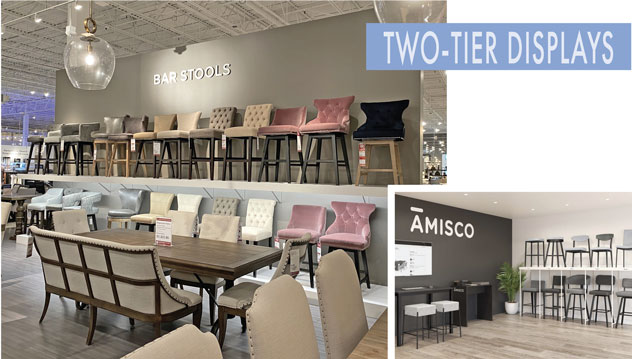
BI-LEVEL BARSTOOL DISPLAYS: A good-looking bi-level
barstool display attracts customers. Many vendors provide displays
that are simple, clean and eye-catching to help customers select
barstool customization options./p>
-
A Two-Level Approach For Accent Chairs.
Accent chairs are an important part of any furniture store offering.
Customers find it helpful to see the different styles displayed in one
place. So, if you do not yet have a designated accent chair area, now is
the time to create one.
Accent chair displays work well within upholstery departments, next to
rug departments or near design centers. Group chairs in pleasing,
eye-catching and easy-to-shop ways. Either place them against a wall
(similar to barstools) using the two-level approach or on display
platforms to provide more visibility and interest.
"You don’t have to spend a fortune to make your showroom look great.
Easily spruce up walls by adding interesting textures or materials that
are faux instead of real."
-
Add Affordable Movable Walls or Hanging Panels.
If your showroom looks like a sea of furniture, consider adding movable
walls or hanging panels behind displays to create visual interest.
Instead of building movable walls made of metal studs and gypsum
board—the most common way builders do this—consider alternative
lightweight materials. Engineered fiberboard, PVC board and
styrene-faced foam board are easier to work with at lower cost.
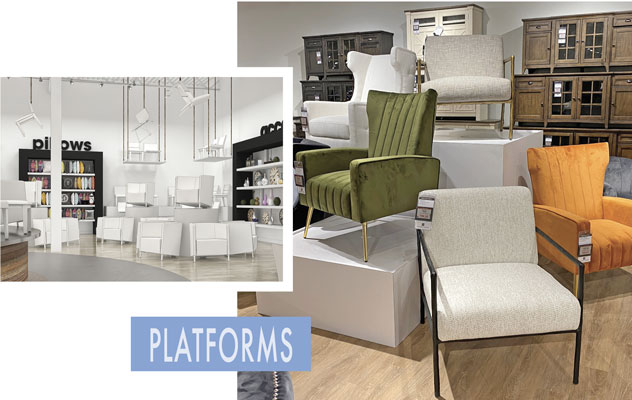
FURNITURE MALL OF MISSOURI: Furniture Mall of
Missouri recently created a different type of accent chair display
(top left). The retailer mixed chairs into their “Marketplace”
area and suspended chairs from the ceiling to make a bold and
playful statement.
LAYER ACCENT CHAIRS: If you do not have adequate
wall space, use platforms to layer accent chair displays to create
more visibility and interest.
Produce lots of visual interest by getting creative with different types
of backdrops. For example:
-
Place shelving units filled with accessories behind room sets to make
a style statement.
-
Hang decorative panels made from locally sourced materials with wire
and hooks or a loop hanger.
-
Source ready-to-go freestanding panels or screens from popular online
sources.
“Instead of building movable walls made of metal studs and gypsum board,
consider alternative lightweight materials. Engineered fiberboard, PVC
board and styrene-faced foam board are easier to work with at lower
cost.”
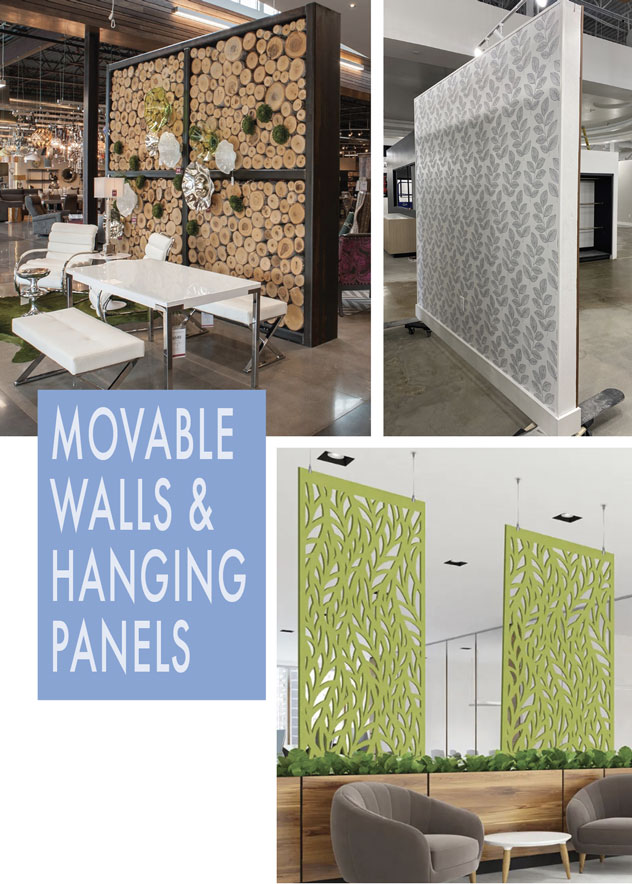
UNIQUE BACKDROPS: Create one-of-a-kind backdrops
for furniture sets, such as the pictured end-grain wood walls by
Montgomery Furniture, wallpapered movable walls by Boulevard Home
and hanging felt panels by Acoufelt.
-
Stone, Tile, and Other Faux Finishes.
You don’t have to spend a fortune to make your showroom look great.
Spruce up walls by adding interesting textures or materials that are
faux instead of real. Want the look of stone, concrete, wood or tile?
These are available in plastic, foam and similar materials at a quarter
of the price. They are so realistic that most shoppers won’t discern the
difference.
Some finishes have simple-to-apply peel-and-stick or direct glue
backings that can be applied without hiring outside help. No messy
mortar, heavy anchoring into walls or complicated cutting is needed.
Retailers can add decorative faux fireplaces and mantels to create a
sense of style and warmth.
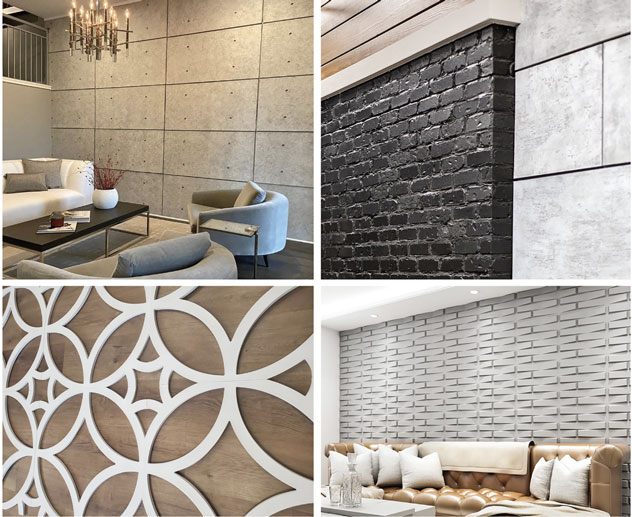
FAUX FINISH LOOKS:: Brick, concrete, stone or wood
looks are all available in faux form at a fraction of the price.
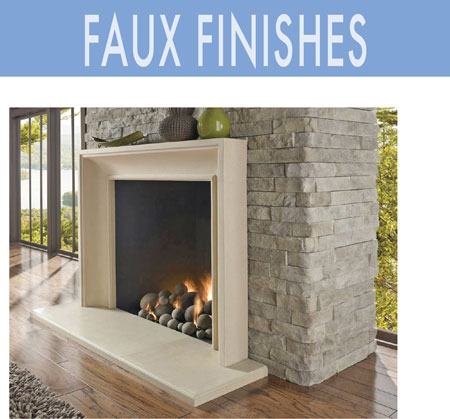
FAUX FIREPLACES: If you are looking to create a
more intimate environment in your showroom, faux fireplaces can add
personality to your room sets at a minimal cost.
-
Apply Paint Freely With Trending Colors.
Applying a fresh coat of paint is still one of the most cost-effective
ways to refresh the look of a store. Although it’s the most basic of all
materials, paint makes an immediate, noticeable improvement. Take
movable walls to a warehouse area or similar space where they can be
easily painted. Or, consider adding wall coverings to create interesting
looks. Don’t be afraid to use accent colors to punch up displays. For
inspiration, check out the “Color of the Year” or “Color Trends” from
paint vendors. Benjamin Moore, for example, provides curated palettes of
colors, such as “Casual Coastal” and “Modern Farmhouse” that are always
current and fresh.
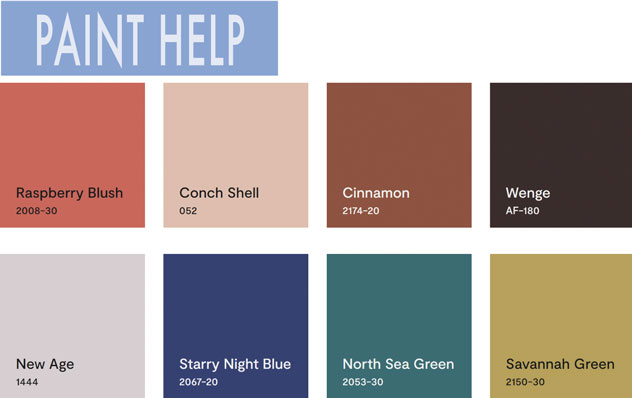
PAINT MANUFACTURERS: If you are unsure about what
accent paint colors to use, manufacturers like Benjamin Moore
(swatches above) share their yearly color trend picks and
recommended designer palettes to make it easy.
-
Consider The Many Excellent Flooring Options.
Moving departments around can present an excellent opportunity to also
change flooring. This may complicate the move and add expense, however
this can be mitigated by choosing flooring tiles, especially LVP/LVTs,
that are easy to lay down over existing hard surfaces. “Click lock”
tiles snap together without glue to easily improve the look of areas.
Carpet, one of the most cost-effective flooring materials, is also
available in tile form. Look for options that are peel-and-stick, easy
to install, and do not require additional gluing.
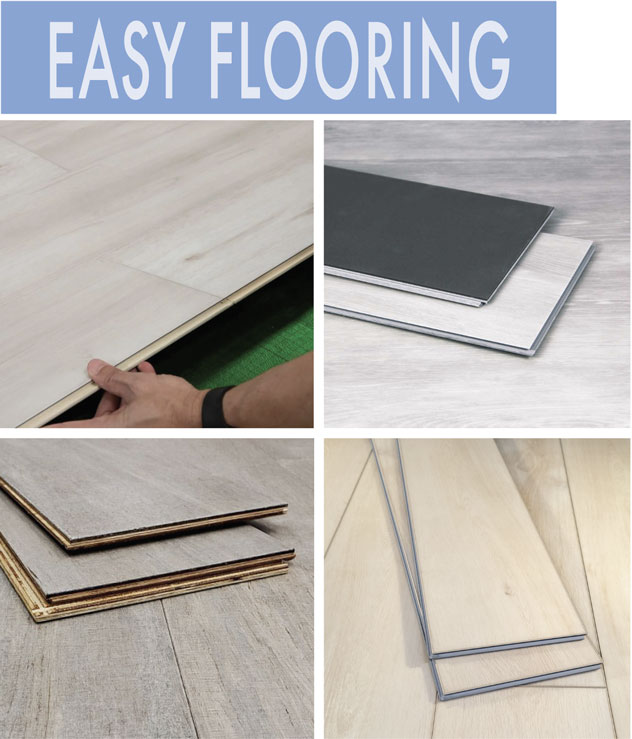
CLICK LOCK FLOORS: To make changing flooring
easy, consider click-lock LVT that can be applied without messy
glue or underlay.
Another attractive option is to leave raw concrete slabs exposed. The
cost depends on the type of floor material that needs to be removed and
the condition of the slab. Raw concrete floors are versatile to work
with, durable, easy to clean, do not require floor transitions and make
moving furniture around easier. They can be stained in a variety of
colors. Rugs, in particular, look great on them.
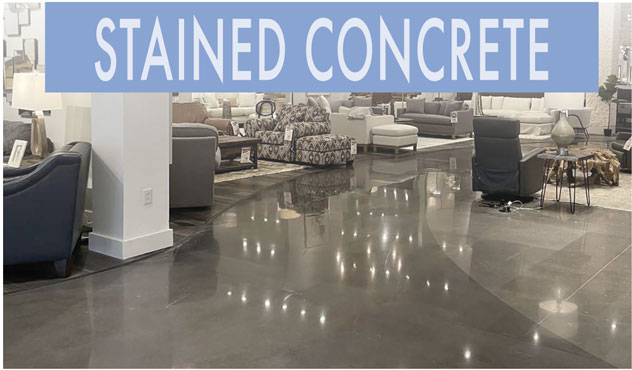
ORIGINAL CONCRETE: Sometimes the easiest floor
surface to go with is the original concrete. Use it in its raw
concrete form or stain it.
"Concrete floors are durable, easy to clean, do not require floor
transitions and make moving furniture around easier. They can be stained in
a variety of colors."
-
Enhance Spaces with Decorative Lighting.
Upgrading showroom lighting is expensive. However, if you have not yet
converted to LED lighting, doing so will offset the cost by reducing
direct electricity costs, HVAC usage and manpower needed to replace
short-lived bulbs. Add decorative chandeliers and pendants to enhance
displays and make a statement. These can also be sold to generate
incremental sales.
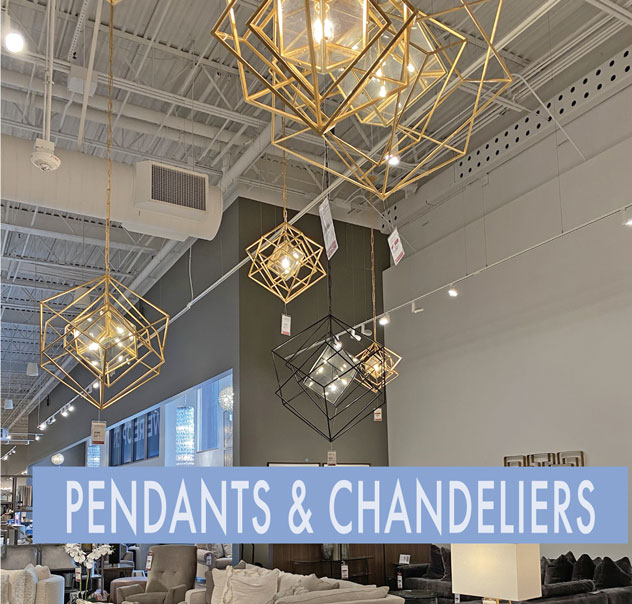
PENDANTS & CHANDELIERS: Introducing decorative pendants and chandeliers into roomsets can completely transform your showroom, taking it to a whole new level.
Use existing light track runs to suspend and power decorative lights.
Consider incorporating accent pendants into customer service areas,
entrances, and at strike zones along circulation paths. String lights
help create attractive looks, especially for patio and dining
departments at low cost. They can be purchased from Amazon or an
industry lighting supplier.
-
Consider Suspended Ceiling Elements.
Nowadays, there are many low-cost and lightweight options for
introducing suspended ceiling elements. These can add interest and
variety to what might otherwise be boring ceilings. Choose ones that are
open and don’t require sprinkler head changes. Consider floating
decorative grids, signage rings, suspended fabric panels and more.
Suspended canopies come in many different shapes and forms. The least
expensive option are canopies of printed fabric stretched over metal
frames.
Canopies can also be produced using lightweight materials such as
styrene-faced Infinity board, CoreLite, and Xanita. With these, a
realistic wood or metal texture can often be printed directly on the
surface. Due to its acoustic value and reasonable cost, mineral wool is
another option to consider. It can be formed into multiple different
shapes, then suspended with wire. Companies like Moss Inc., Acoufelt,
and Muffle all offer standard ceiling products that can be ordered
online and shipped directly to stores.
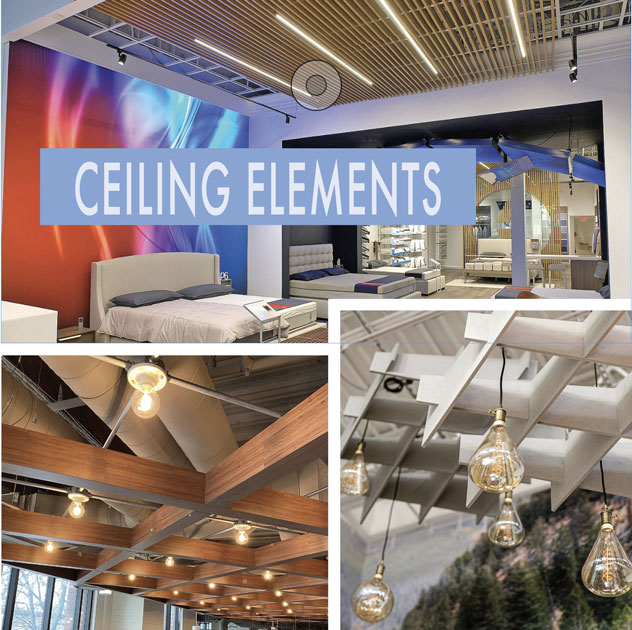
FAUX WOOD SLATS: Sleep Number’s new NYC mattress showroom (top photo) takes advantage of faux wood slat treatments both on walls and ceilings to add a sense of warmth to its technology-heavy space.
FAUX WOOD CEILING GRIDS: Open decorative grid ceilings using faux finishes (such as a printed wood texture on foam beams or a felt material) can be a great way to work around existing building limitations, like sprinkler head issues.
-
Explore Signage Opportunities.
If you have not yet considered integrating your brand message into the
in-store experience, it’s not too late. In-store brand messaging
communicates your store’s values and the benefits you provide to
customers. Use simple wording, phrases and emotive concepts. For
example, Tepperman’s adds dimensional lettering around the perimeters of
its stores using words like “Relax” or “Sleep.”
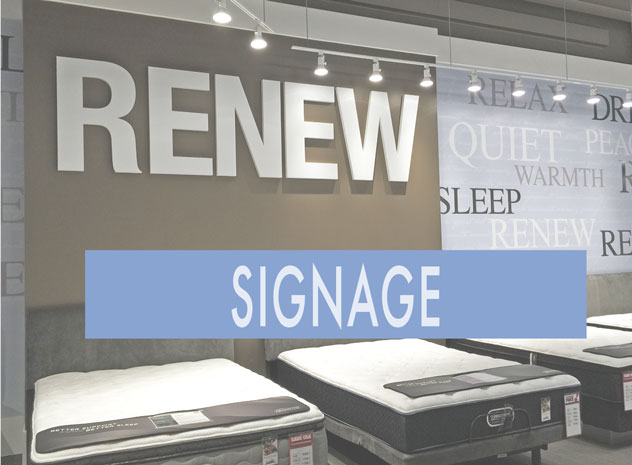
DIMENSIONAL SIGNAGE: Make a bold statement by adding dimensional signage on major feature walls like Tepperman’s does in its major departments.
Dimensional letters are inexpensive if cut out of materials such as
Sintra board or foam core. Local signage shops can help make
presentations come to life. Use dimensional lettering to make a brand
statement, tell a story or mark a department. Bassett stores, for
example, use dimensional lettering to enhance their in-store messaging.
Another low-cost way to introduce signage is with pole banners that
attach directly to columns. These flags can be used to sign departments,
communicate store values, share promotional opportunities and much more.
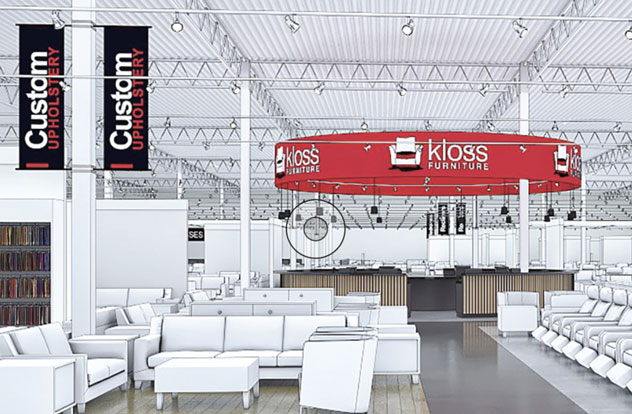
CANOPY AND COLUMN SIGNAGE: Kloss Furniture hangs vertical banner signs from columns to announce departments and communicate important brand statements (below). Also note the bold, suspended canopy sign over Kloss’ customer service area.
There are many ways to enhance the look of your store without spending a
fortune. All it takes is imagination and some know-how. Even small changes
can improve the shopping experience, excite customers, encourage them to
browse more of your store and lead to more sales.
Instead of building movable walls made of metal studs and gypsum board,
consider alternative lightweight materials. Engineered fiberboard, PVC board
and styrene-faced foam board are easier to work with at lower cost.